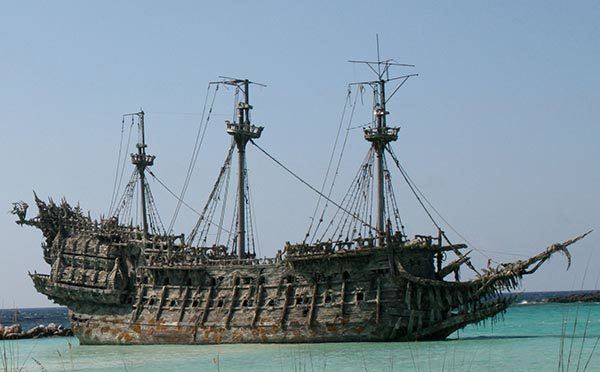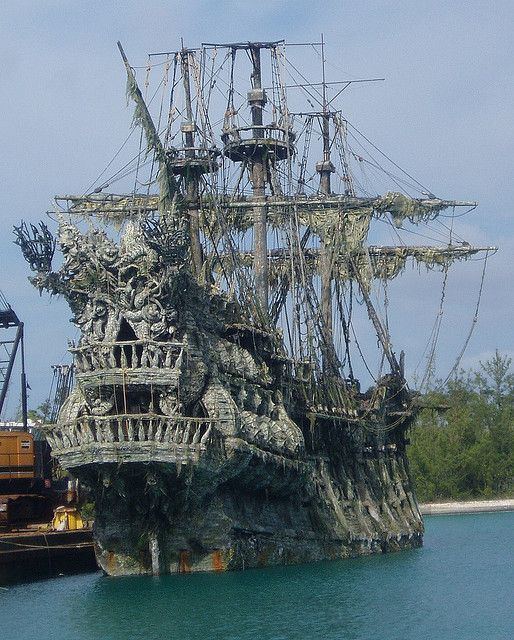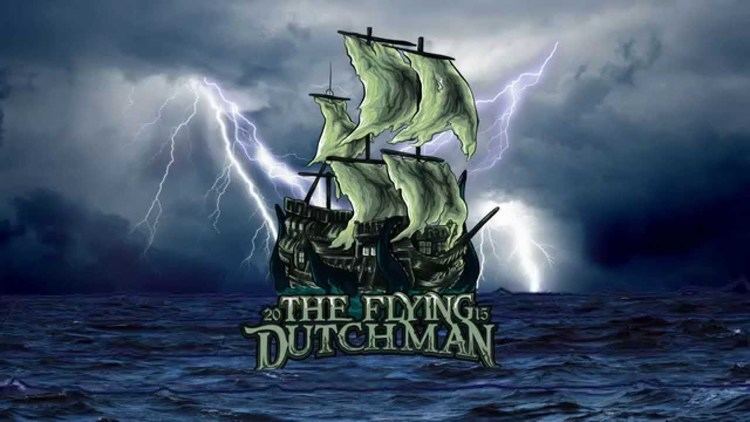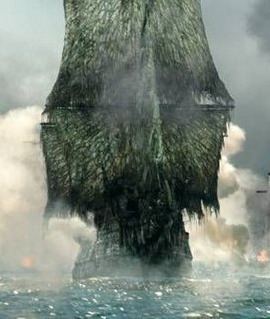Color Glowing green | Eye color Yellow with black irises | |
 | ||
Captain Hendrick van der Decken Residence Flying Dutchman's Ship, 124 Conch Street Interests Zapping those who disagree with him, Scaring victims, Terrifying innocent people, Making fancy rope knots, Taking souls Foes Squidward Tentacles, Mr. Krabs, Lord Poltergeist Similar Davy Jones, Davy Jones' Locker, Will Turner, Jack Sparrow, Hector Barbossa | ||
Spongebob squarepants revenge of the flying dutchman 20 100 gamecube longplay
The Flying Dutchman (Dutch: De Vliegende Hollander) is a legendary ghost ship that can never make port and is doomed to sail the oceans forever. The myth is likely to have originated from 17th-century nautical folklore. The oldest extant version has been dated to the late 18th century. Sightings in the 19th and 20th centuries reported the ship to be glowing with ghostly light. If hailed by another ship, the crew of the Flying Dutchman will try to send messages to land, or to people long dead. In ocean lore, the sight of this phantom ship is a portent of doom.
Contents
- Spongebob squarepants revenge of the flying dutchman 20 100 gamecube longplay
- Origins
- Reported sightings
- Explanations as an optical illusion
- Adaptations
- In artworks and design
- In television series and comics
- In film
- In literature
- In opera and theatre
- In music
- In radio drama
- In video games
- In leisure
- In aviation
- In education
- References

Origins

The first print reference to the ship appears in Travels in various part of Europe, Asia and Africa during a series of thirty years and upward (1790) by John MacDonald :

The weather was so stormy that the sailors said they saw the flying Dutchman. The common story is that this Dutchman came to the Cape in distress of weather and wanted to get into harbour but could not get a pilot to conduct her and was lost and that ever since in very bad weather her vision appears.
The next literary reference appears in Chapter VI of A Voyage to Botany Bay (1795) (also known as A Voyage to New South Wales), attributed to George Barrington (1755–1804):
I had often heard of the superstition of sailors respecting apparitions and doom, but had never given much credit to the report; it seems that some years since a Dutch man-of-war was lost off the Cape of Good Hope, and every soul on board perished; her consort weathered the gale, and arrived soon after at the Cape. Having refitted, and returning to Europe, they were assailed by a violent tempest nearly in the same latitude. In the night watch some of the people saw, or imagined they saw, a vessel standing for them under a press of sail, as though she would run them down: one in particular affirmed it was the ship that had foundered in the former gale, and that it must certainly be her, or the apparition of her; but on its clearing up, the object, a dark thick cloud, disappeared. Nothing could do away the idea of this phenomenon on the minds of the sailors; and, on their relating the circumstances when they arrived in port, the story spread like wild-fire, and the supposed phantom was called the Flying Dutchman. From the Dutch the English seamen got the infatuation, and there are very few Indiamen, but what has some one on board, who pretends to have seen the apparition.
The next literary reference introduces the motif of punishment for a crime, in Scenes of Infancy (Edinburgh, 1803) by John Leyden (1775–1811):
It is a common superstition of mariners, that, in the high southern latitudes on the coast of Africa, hurricanes are frequently ushered in by the appearance of a spectre-ship, denominated the Flying Dutchman ... The crew of this vessel are supposed to have been guilty of some dreadful crime, in the infancy of navigation; and to have been stricken with pestilence ... and are ordained still to traverse the ocean on which they perished, till the period of their penance expire.
Thomas Moore (1779–1852) places the vessel in the north Atlantic in his poem Written on passing Dead-man's Island in the Gulf of St. Lawrence, Late in the evening, September, 1804: "Fast gliding along, a gloomy bark / Her sails are full, though the wind is still, / And there blows not a breath her sails to fill." A footnote adds: "The above lines were suggested by a superstition very common among sailors, who call this ghost-ship, I think, 'the Flying Dutch-man'."
Sir Walter Scott (1771–1832), a friend of John Leyden's, was the first to refer to the vessel as a pirate ship, writing in the notes to Rokeby; a poem (first published December 1812) that the ship was "originally a vessel loaded with great wealth, on board of which some horrid act of murder and piracy had been committed" and that the apparition of the ship "is considered by the mariners as the worst of all possible omens."
According to some sources, 17th century Dutch captain Bernard Fokke is the model for the captain of the ghost ship. Fokke was renowned for the speed of his trips from the Netherlands to Java and was suspected of being in league with the Devil. The first version of the legend as a story was printed in Blackwood's Edinburgh Magazine for May 1821, which puts the scene as the Cape of Good Hope. This story introduces the name Captain Hendrick Van der Decken for the captain and the motifs (elaborated by later writers) of letters addressed to people long dead being offered to other ships for delivery, but if accepted will bring misfortune; and the captain having sworn to round the Cape of Good Hope though it should take until the day of judgment.
She was an Amsterdam vessel and sailed from port seventy years ago. Her master's name was Van der Decken. He was a staunch seaman, and would have his own way in spite of the devil. For all that, never a sailor under him had reason to complain; though how it is on board with them nobody knows. The story is this: that in doubling the Cape they were a long day trying to weather the Table Bay. However, the wind headed them, and went against them more and more, and Van der Decken walked the deck, swearing at the wind. Just after sunset a vessel spoke him, asking him if he did not mean to go into the bay that night. Van der Decken replied: "May I be eternally damned if I do, though I should beat about here till the day of judgment." And to be sure, he never did go into that bay, for it is believed that he continues to beat about in these seas still, and will do so long enough. This vessel is never seen but with foul weather along with her.
Reported sightings
There have been many reported or alleged sightings in the 19th and 20th centuries. Nicholas Monsarrat, the famous novelist who wrote The Cruel Sea, apparently saw the phenomenon in the Pacific Ocean when serving in the minesweeper HMS Jubilee as a Royal Navy officer during the Second World War. Unfortunately he made no mention of this in his two volume autobiography or other works and HMS Jubilee did not, in fact, exist. Monsarrat's connection probably stems from his book "Master Mariner" which was partly inspired by this tale (he lived and worked in South Africa after the war) and the story of the Wandering Jew. Another sighting was by Prince George of Wales, the future King George V. He was on a three-year voyage during his late adolescence in 1880 with his elder brother Prince Albert Victor of Wales and their tutor John Neill Dalton. They temporarily shipped into HMS Inconstant after the damaged rudder was repaired in their original ship, the 4,000-tonne corvette Bacchante. The princes' log (indeterminate as to which prince, due to later editing before publication) records the following for the pre-dawn hours of 11 July 1881, off the coast of Australia in the Bass Strait between Melbourne and Sydney:
July 11th. At 4 a.m. the Flying Dutchman crossed our bows. A strange red light as of a phantom ship all aglow, in the midst of which light the masts, spars and sails of a brig 200 yards distant stood out in strong relief as she came up on the port bow, where also the officer of the watch from the bridge clearly saw her, as did the quarterdeck midshipman, who was sent forward at once to the forecastle; but on arriving there was no vestige nor any sign whatever of any material ship was to be seen either near or right away to the horizon, the night being clear and the sea calm. Thirteen persons altogether saw her ... At 10.45 a.m. the ordinary seaman who had this morning reported the Flying Dutchman fell from the foretopmast crosstrees on to the topgallant forecastle and was smashed to atoms.
Explanations as an optical illusion
Probably the most credible explanation is a superior mirage or Fata Morgana seen at sea.
The news soon spread through the vessel that a phantom-ship with a ghostly crew was sailing in the air over a phantom-ocean, and that it was a bad omen, and meant that not one of them should ever see land again. The captain was told the wonderful tale, and coming on deck, he explained to the sailors that this strange appearance was caused by the reflection of some ship that was sailing on the water below this image, but at such a distance they could not see it. There were certain conditions of the atmosphere, he said, when the sun's rays could form a perfect picture in the air of objects on the earth, like the images one sees in glass or water, but they were not generally upright, as in the case of this ship, but reversed—turned bottom upwards. This appearance in the air is called a mirage. He told a sailor to go up to the foretop and look beyond the phantom-ship. The man obeyed, and reported that he could see on the water, below the ship in the air, one precisely like it. Just then another ship was seen in the air, only this one was a steamship, and was bottom-upwards, as the captain had said these mirages generally appeared. Soon after, the steamship itself came in sight. The sailors were now convinced, and never afterwards believed in phantom-ships.
Another optical effect known as looming occurs when rays of light are bent across different refractive indices. This could make a ship just off the horizon appear hoisted in the air.
Adaptations
There is a 20-foot one-design high-performance two-person monohull racing dinghy named the Flying Dutchman (FD). It made its Olympic debut at the 1960 Olympics Games and is still one of the fastest racing dinghies in the world.
In artworks and design
The Flying Dutchman has been captured in paintings by Albert Ryder, now in the Smithsonian American Art Museum, Washington, D.C., and by Howard Pyle, whose painting of the Flying Dutchman is on exhibit at the Delaware Art Museum.
Dutch artist Joyce Overheul also adapted the name of The Flying Dutchman onto her crochet pattern designs (The Flying Dutchman Crochet Design), resembling the similarity of her designs 'roaming' the world just like the ghost ship once did.
Flying Dutchman Tobacco was a popular blend for pipes and smoking. Many of their tins are still readily collected by those who appreciate packaging art and design.
In television series and comics
In film
The story was dramatised in the 1951 film Pandora and the Flying Dutchman, starring James Mason (who plays the Dutch Captain Hendrick van der Zee) and Ava Gardner (who plays Pandora). In this version, the Flying Dutchman is a man, not a ship. The two-hour long film, scripted by its director Albert Lewin, sets the main action on the Mediterranean coast of Spain during the summer of 1930. Centuries earlier the Dutchman had killed his wife, wrongly believing her to be unfaithful. Providence condemned him to roam the seas until he found the true meaning of love. In the only plot device taken from earlier versions of the story, once every seven years the Dutchman is allowed ashore for six months to search for a woman who will love him enough to die for him, releasing him from his curse, and he finds her in Pandora.
In Disney's Pirates of the Caribbean films, the ship made its first appearance in Dead Man's Chest (2006) under the command of the fictional captain, Davy Jones. The story and attributes of the ship were inspired by the actual Flying Dutchman of nautical lore.
In literature
The 1797–98 poem by Samuel Taylor Coleridge, The Rime of the Ancient Mariner, contains a similar account of a ghost ship, which may have been influenced by the tale of the Flying Dutchman. One of the first Flying Dutchman short stories was titled "Vanderdecken's Message Home; or, the Tenacity of Natural Affection" and was published in Blackwood's during 1821.
This story was adapted in the English melodrama The Flying Dutchman; or The Phantom Ship: a Nautical Drama, in three acts (1826) by Edward Fitzball (1792–1873), music by George Rodwell, and the novel The Phantom Ship (1839) by Frederick Marryat. This in turn was later adapted as Het Vliegend Schip (The Flying Ship) by the Dutch clergyman, A. H. C. Römer. In Marryat's version, Terneuzen, in the Netherlands, is described as the home of the captain, who is called "Van der Decken" ("of the decks").
Another adaptation was The Flying Dutchman on Tappan Sea by Washington Irving (1855), in which the captain is named Ramhout van Dam. Irving had already used the story (based on Moore's poem) in his Bracebridge Hall (1822). Hedvig Ekdal describes visions of the Flying Dutchman from the books she reads in the attic in Henrik Ibsen's The Wild Duck (1884).
John Boyle O'Reilly's The Flying Dutchman was first published in The Wild Goose, a handwritten newspaper produced by Fenian convicts being transported to Western Australia in 1867.
British author Brian Jacques wrote a trilogy of fantasy/young adult novels concerning two reluctant members of the Dutchman's crew, a young boy and his dog, who were swept off the ship by a wave on the night the ship was cursed; however, the same angel who pronounced the curse on the ship and crew appeared to them and blessed them, charging them to help those in need . The first novel was titled Castaways of the Flying Dutchman and was first published by Puffin Books in 2001. The second was titled The Angel's Command and was released by Puffin in 2003. The third and final book of the trilogy (due to Jacques' death in 2011) was titled Voyage of Slaves and was released by Puffin in 2006.
In the novel The Flying Dutchman (2013) by the Russian novelist Anatoly Kudryavitsky, the ghost ship rebuilds itself from an old barge abandoned on the bank of a big Russian river, and offers itself as a refuge to a persecuted musicologist.
The comic fantasy Flying Dutch by Tom Holt is a version of the Flying Dutchman story. In this version, the Dutchman is not a ghost ship but crewed by immortals who can only visit land once every seven years when the unbearable smell that is a side-effect of the elixir of life wears off.
The Roger Zelazny short story "And Only I Am Escaped To Tell thee" tells of a sailor who escapes from the Flying Dutchman and is rescued by sailors who welcome him to the Mary Celeste.
Ward Moore in his 1951 story "Flying Dutchman" used the myth as a metaphor for an automated bomber plane which continues to fly over an Earth where humanity long since totally destroyed itself and all life in a nuclear war.
Amiri Baraka's 1964 play, Dutchman, uses the metaphor of ship-lost-at-sea to express the way White liberal America has alienated African Americans in their own country.
In opera and theatre
Richard Wagner's opera, The Flying Dutchman (1843) is adapted from an episode in Heinrich Heine's satirical novel The Memoirs of Mister von Schnabelewopski (Aus den Memoiren des Herrn von Schnabelewopski) (1833), in which a character attends a theatrical performance of The Flying Dutchman in Amsterdam. Heine had first briefly used the legend in his Reisebilder: Die Nordsee (Pictures of Travel: the North Sea) (1826), which simply repeats from Blackwood's Magazine the features of the vessel being seen in a storm and sending letters addressed to persons long since dead. In his 1833 elaboration, it was once thought that it may have been based on Fitzball's play, which was playing at the Adelphi Theatre in London, but the run had ended on 7 April 1827 and Heine did not arrive in London until the 14th. Heine was the first author to introduce the chance of salvation through a woman's devotion and the opportunity to set foot on land every seven years to seek a faithful wife. This imaginary play, unlike Fitzball's play, which has the Cape of Good Hope location, in Heine's account is transferred to the North Sea off Scotland. Wagner's opera was similarly planned to take place off the coast of Scotland, although during the final rehearsals he transferred the action to another part of the North Sea, off Norway.
Pierre-Louis Dietsch composed an opera Le vaisseau fantôme, ou Le maudit des mers ("The Phantom Ship, or The Accursed of the Sea"), which was first performed on 9 November 1842 at the Paris Opera. The libretto by Paul Foucher and H. Révoil was based on Walter Scott's The Pirate as well as Captain Marryat's The Phantom Ship and other sources, although Wagner thought it was based on the scenario of his own opera, which he had just sold to the Opera. The similarity of Dietsch's opera to Wagner's is slight, although Wagner's assertion is often repeated. Berlioz thought Le vaisseau fantôme too solemn, but other reviewers were more favourable.
Amiri Baraka (formerly LeRoi Jones) wrote the play Dutchman in 1964. The play's abstract nature makes it difficult to draw a direct correlation between it and the myth, but its emphasis on fate and doom recasts themes of the legend in terms of race relations in the contemporary United States.
In music
Jole Richard Hughes, better known by his stage name S3RL, is an Australian UK hardcore DJ, record producer and musician from Brisbane has a song titled "Flying Dutchman" based on the tales and the legend itself.
In radio drama
The story was adapted by Judith French into a play, The Dutch Mariner, broadcast on BBC Radio 4 on 13 April 2003.
In video games
The Flying Dutchman is a cheat unit in the original Age of Empires computer game. It is a ship that can travel on both land and sea.
In the 1993 multiplatform game Alone in the Dark 2, fictional detective Edward Carnby investigates a missing girl who he discovers has been kidnapped by the undead One-Eyed Jack who, in the game, is captain of the undead crew of The Flying Dutchman.
The Flying Dutchman is depicted in the sandbox platformer game Terraria as a flying wooden ship with four destructible, broadside cannons. It appears within the Pirate Invasion as a boss enemy.
The Flying Dutchman is also used as a warship in a game called Warship Battle:3D .
In leisure
The Efteling amusement park in the Netherlands has a roller coaster called The Flying Dutchman which features a character named Willem van der Decken.
Worlds of Fun amusement park in Kansas City, Missouri has a swinging boat ride called The Flying Dutchman.
The Haunted Mansion attraction in Disneyland features a painting of the Flying Dutchman before it became a ghost ship that transforms into a ship with torn sails sailing during a storm.
In Disneyland Shanghai, the park's Pirates of the Caribbean Ride features a battle between ships under the sea; one of which is the "Flying Dutchman".
In aviation
KLM Royal Dutch Airlines references the endless traveling aspect of the story by having The Flying Dutchman painted on the rear sides of on all its aircraft with regular livery.
In education
The nickname of Lebanon Valley College is "The Flying Dutchmen", and its mascot "The Flying Dutchman". The nickname references the college's location in the Pennsylvania Dutch Country.
Hofstra University in Long Island, New York was unofficially named "The Flying Dutchman" and has many references to Dutch culture around the university including residence halls.
Hope College in Holland, Michigan is also the home of "The Flying Dutchman" because it was founded by settlers from the Netherlands in 1866.
